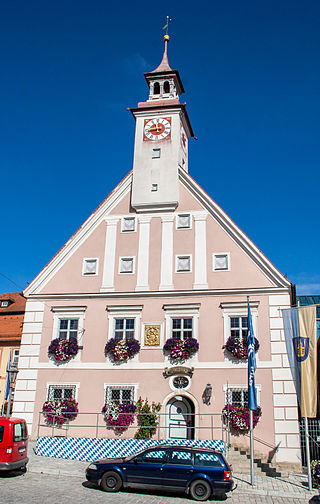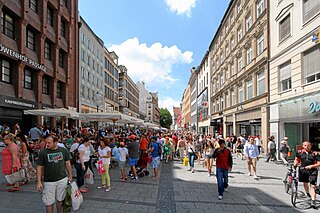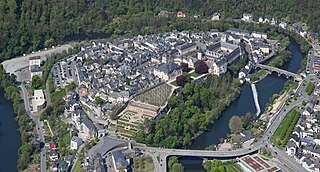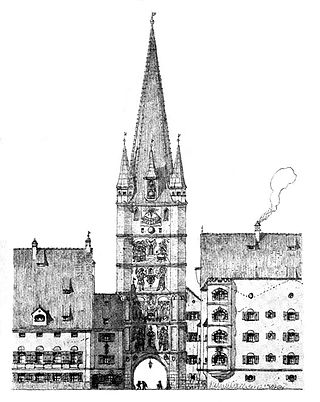
Melk is a city in the Austrian state of Lower Austria, next to the Wachau valley along the Danube. Melk has a population of 5,257. It is best known as the site of a massive baroque Benedictine monastery named Melk Abbey.

Homberg is a small town in the northern part of Hesse, a state in central Germany, with about 15,000 inhabitants. It is the seat of the Schwalm-Eder district. In 2008, the town hosted the 48th Hessentag state festival.

Pegau is a town in the Leipzig district in Saxony, Germany, situated in a fertile plain, on the White Elster, 18 m. S.W. from Leipzig by the railway to Zeitz.

Weißenhorn is a town in the district of Neu-Ulm in Bavaria. Weißenhorn is located about 22 km southeast of Ulm.

The Frauenkirche is a church in Munich, Bavaria, Germany, that serves as the cathedral of the Archdiocese of Munich and Freising and seat of its Archbishop. It is a landmark and is considered a symbol of the Bavarian capital city. Although called "Münchner Dom" on its website and URL, the church is referred to as "Frauenkirche" by locals.

Marienplatz is a central square in the city centre of Munich, Germany. It has been the city's main square since 1158.

Greding is a town in the district of Roth, in Bavaria, Germany. It is situated 28 km southeast of Roth bei Nürnberg and 32 km north of Ingolstadt.

The New Town Hall is a town hall forms the northern part of Marienplatz in Munich, Bavaria, Germany. It hosts the city government including the city council, offices of the mayors and a small portion of the administration. In 1874 the municipality had left the Old Town Hall for its new domicile.

Duchroth is an Ortsgemeinde – a municipality belonging to a Verbandsgemeinde, a kind of collective municipality – in the Bad Kreuznach district in Rhineland-Palatinate, Germany. It belongs to the Verbandsgemeinde of Rüdesheim, whose seat is in the like-named town. Duchroth is a winegrowing centre and lies in the Soonwald-Nahe Nature Park.

This article gives an overview about the architecture of Munich, Germany.

Bremen City Hall is the seat of the President of the Senate and Mayor of Bremen, Germany. It is one of the most important examples of Brick Gothic and Weser Renaissance architecture in Europe. Since 1973, it has been a protected historical building. In July 2004, along with the Bremen Roland statue, the building was added to the list of UNESCO World Heritage Sites because of its outstanding architecture and its testimony to the development of civic autonomy in the Holy Roman Empire.

The Old Town Hall, until 1874 the domicile of the municipality, serves today as a building for representative purposes for the city council in Munich, Bavaria, Germany. The Old Town Hall bounds the central square Marienplatz on its east side.

The City Hall is a historical building in Cologne, western Germany. It is located off Hohe Straße in the district of Innenstadt, and set between the two squares of Rathausplatz and Alter Markt. It houses part of the city government, including the city council and offices of the Lord Mayor. It is Germany's oldest city hall with a documented history spanning some 900 years. The history of its council during the 11th century is a prominent example for self-gained municipal autonomy of Medieval cities.

Karlstor in Munich is a medieval city gate, which served as a defensive fortification and a checkpoint.

The New Town Hall has stood on the Domshof in the centre of Bremen, Germany since 1913. Located behind the Unser-Lieben-Frauen-Kirchhof cemetery, it is adjacent to the older section of the Town Hall with which it forms a harmonious ensemble. Among its sumptuous rooms decorated with local artefacts, the New Town Hall houses the Senate Chamber used by the Senate for its regular meetings and the Great Hall, a venue for official receptions. In 2004, Bremen Town Hall was listed as a UNESCO World Heritage Site, together with the Roland of Bremen, because of its outstanding architecture and testimony to the development of civic autonomy during the Holy Roman Empire.

The Town Hall of Osnabrück, Germany, was built in the late Gothic style from 1487 to 1512. It is one of Osnabrück's most important buildings and emblems and continues to be used as the city's town hall today. The Treaty of Westphalia was negotiated and signed by the combatants of the Thirty Years’ War at the town halls of Osnabrück and Münster in 1648.

The Kaufingerstraße is one of the oldest streets in Munich and, together with the Neuhauser Straße, one of the most important shopping streets in Munich.

Schloss Weilburg is a Baroque schloss in Weilburg, Hesse, Germany. It is located on a spur above the river Lahn and occupies about half of the area of the Old Town of Weilburg. It contains the Hochschloss, built between 1530 and 1572, which is one of the best-preserved Renaissance palaces in Hesse. In the 1700s, the palace was expanded by John Ernst, Count of Nassau-Weilburg, and his builder, Julius Ludwig Rothweil. The buildings and gardens now belong to the Verwaltung der Staatlichen Schlösser und Gärten Hessen, and they can be visited as a museum on guided tours. Parts of the palace are venues for the music festival Weilburger Schlosskonzerte, which is named after the palace.

The Kaufingertor was one of the five city gates built around at the end of the 12th century, as the first city walls of medieval Munich. It was located in the west of the old town, approximately at the point where today's Färbergraben and Augustinerstraße meet on Kaufingerstraße.



















